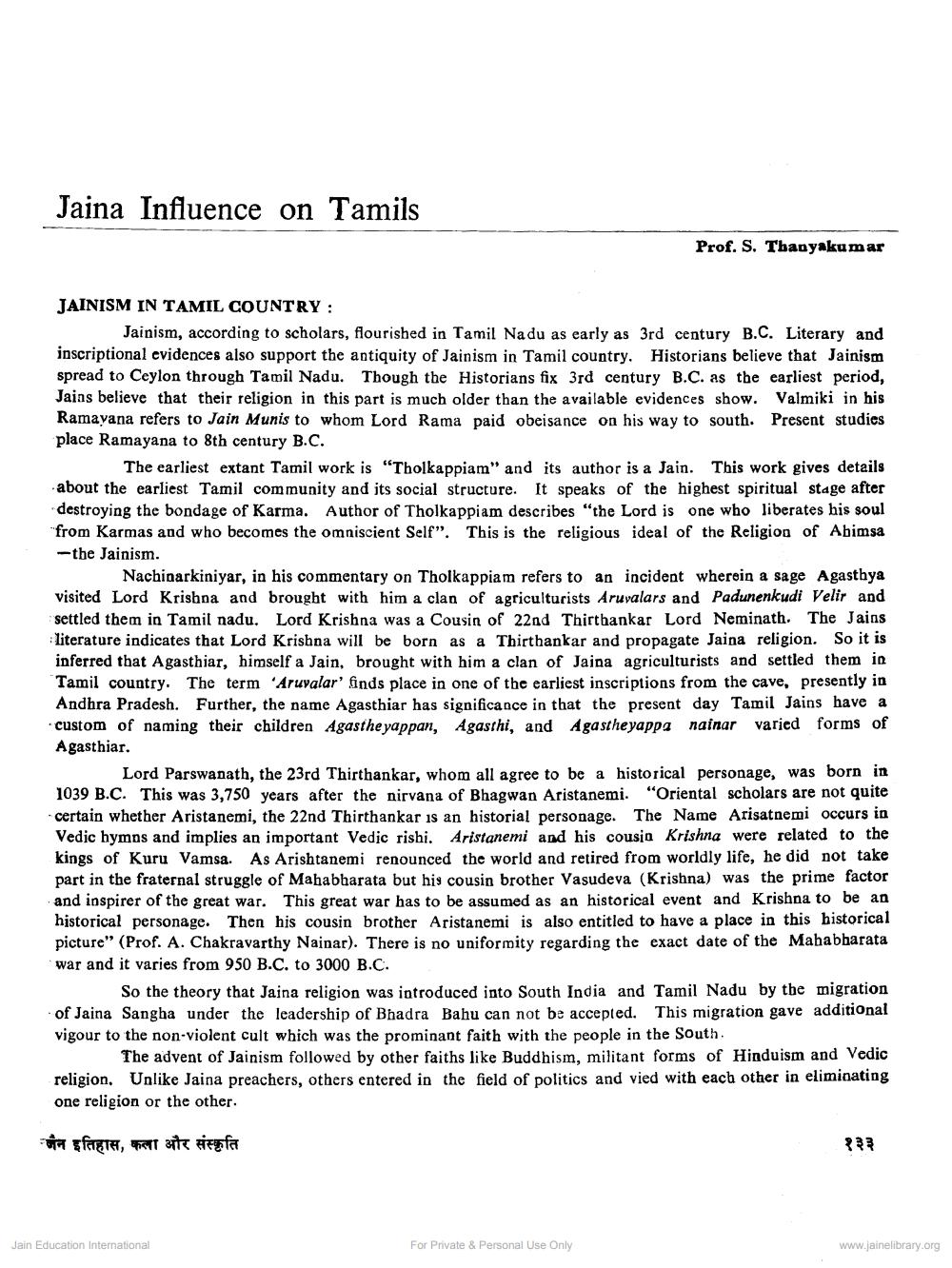________________
Jaina Influence on Tamils
Prof. S. Tbanyakumar
JAINISM IN TAMIL COUNTRY:
Jainism, according to scholars, flourished in Tamil Nadu as early as 3rd century B.C. Literary and inscriptional evidences also support the antiquity of Jainism in Tamil country. Historians believe that Jainism spread to Ceylon through Tamil Nadu. Though the Historians fix 3rd century B.C. as the earliest period, Jains believe that their religion in this part is much older than the available evidences show. Valmiki in his Ramayana refers to Jain Munis to whom Lord Rama paid obeisance on his way to south. Present studies place Ramayana to 8th century B.C.
The earliest extant Tamil work is "Tholkappiam" and its author is a Jain. This work gives details about the earliest Tamil community and its social structure. It speaks of the highest spiritual stage after destroying the bondage of Karma. Author of Tholkappiam describes "the Lord is one who liberates his soul from Karmas and who becomes the omniscient Self". This is the religious ideal of the Religion of Abimsa -the Jainism.
Nachinarkiniyar, in his commentary on Tholkappiam refers to an incident wherein a sage Agasthya visited Lord Krishna and brought with him a clan of agriculturists Aruvalars and Padunenkudi Velir and settled them in Tamil nadu. Lord Krishna was a Cousin of 22nd Thirthankar Lord Neminath. The Jains literature indicates that Lord Krishna will be born as a Thirthankar and propagate Jaina religion. So it is inferred that Agasthiar, himself a Jain, brought with him a clan of Jaina agriculturists and settled them in Tamil country. The term 'Aruvalar' finds place in one of the earliest inscriptions from the cave, presently in Andhra Pradesh. Further, the name Agasthiar has significance in that the present day Tamil Jains have a custom of naming their children Agasthe yappan, Agasthi, and Agastheyappa nainar varied forms of Agasthiar.
Lord Parswanath, the 23rd Thirthankar, whom all agree to be a historical personage, was born in 1039 B.C. This was 3,750 years after the nirvana of Bhagwan Aristanemi. "Oriental scholars are not quite - certain whether Aristanemi, the 22nd Thirthankar is an historial personage. The Name Arisatnemi occurs in Vedic hymns and implies an important Vedic rishi. Aristanemi and his cousin Krishna were related to the kings of Kuru Vamsa. As Arishtanemi renounced the world and retired from worldly life, he did not take part in the fraternal struggle of Mahabharata but his cousin brother Vasudeva (Krishna) was the prime factor and inspirer of the great war. This great war has to be assumed as an historical event and Krishna to be an historical personage. Then his cousin brother Aristanemi is also entitled to have a place in this historical picture" (Prof. A. Chakravarthy Nainar). There is no uniformity regarding the exact date of the Mahabharata war and it varies from 950 B.C. to 3000 B.C.
So the theory that Jaina religion was introduced into South India and Tamil Nadu by the migration of Jaina Sangha under the leadership of Bhadra Bahu can not be accepted. This migration gave additional vigour to the non-violent cult which was the prominant faith with the people in the South
The advent of Jainism followed by other faiths like Buddhism, militant forms of Hinduism and Vedic religion. Unlike Jaina preachers, others entered in the field of politics and vied with each other in eliminating one religion or the other.
जैन इतिहास, कला और संस्कृति
Jain Education International
For Private & Personal Use Only
www.jainelibrary.org




